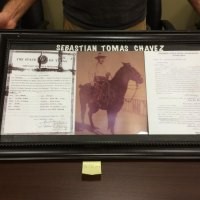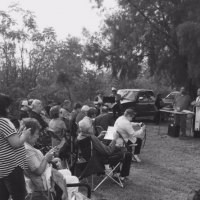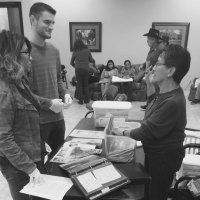Starting in the small city of Somerset on Nov. 14, Northwest Vista College instructors and students invited the public to bring family photos, letters, artifacts or anything of interest that documents San Antonio’s history. What the team found was eye-opening.
- An 1833 letter from the mayor of San Antonio – Francisco Antonio Ruiz, who’s, Father Jose Francisco Ruiz, was one of the people who signed the Texas Declaration of Independence from Mexico. Francisco Antonio Ruiz was also the mayor during the siege of the Battle of the Alamo;
- Tax records dating back to the civil war of the 1850’s;
- Family photos, dating back to the 1800’s;
- And a 1917 photo of one of the first Mexican Texas Ranger – Private Sebastian Tomas Chavez, who’s occupation was a fence rider. He was inducted into the Texas Rangers on Dec. 18, 1917 at the age of 33.
This project is in collaboration between Northwest Vista College and the American Indians in Texas at the Spanish Colonial Missions, which is a nonprofit organization established by the Tap Pilam Coahuiltecan Nation – descendants of the original people who populated South Texas and Northeast Mexico, and who are recognized by the city of San Antonio to be the direct descendants of the Mission Indians of the San Antonio Missions. The organization works for the preservation of the culture of the Native Americans who resided in the Spanish colonial missions.
 NVC instructor Rudy De La Cruz said this is one of the first archives of its kind that will show Bexar County’s multicultural background, and tell a more inclusive story of San Antonio. He added the benefit of this community partnership between NVC and the American Indians is that researchers get to learn how and why many of the native populations assimilated into the Mexican American culture to survive; and researchers can help the American Indians better document their past.
NVC instructor Rudy De La Cruz said this is one of the first archives of its kind that will show Bexar County’s multicultural background, and tell a more inclusive story of San Antonio. He added the benefit of this community partnership between NVC and the American Indians is that researchers get to learn how and why many of the native populations assimilated into the Mexican American culture to survive; and researchers can help the American Indians better document their past.
Prior to visiting Somerset, Rudy and Juan Ramon Vasquez of the American Indians, and Art Martinez de Vara, former mayor of Von Ormy and the president of its historical society, also visited with descendants of Blas María Herrera, who was a solider and scout and often called the “Paul Revere” of the Texas Revolution. One of his many scouting duties included finding out how close the Mexican military was to San Antonio in 1836 prior to the Battle of the Alamo. Annually, the Ruiz-Herrera families gather on Dia De los Muertos or Oct. 31 to celebrate past family members. From this visit, a few of the Blas-Herrera family members brought out artifacts at the Nov. 14 data-gathering event.
In Somerset alone, a cache of history was scanned and documented from the nearly 50 people who brought personal belongings of their ancestors. The next stops include Losoya, Boerne, Fredericksburg, New Braunfels and others. Rudy said the goal is to find descendants of families who came from France, Ireland, Germany, Britain, Spain and other countries during the colonial and post colonial periods.
“We are seeking out sources that were left out of the narratives,” Rudy said. “We are going to the neighboring cities and asking the descendants of the early Tejano settlers.”
 Juan Ramon Vasquez, said this is the first time the American Indians is taking part in a community partnership that includes researching their own past.
Juan Ramon Vasquez, said this is the first time the American Indians is taking part in a community partnership that includes researching their own past.
“When it comes to American Indians, we usually have our story told to us and this way we get to participate in telling our own story,” Juan said. The Mission Indians were here before the Spaniards and they are the ones who became the Tejanos and played a major role in the liberty and independence of Texas.”
While this project is still unfolding, Rudy is also trying to partner with the Land Heritage Institute & The Richard Beene site for the development of an archeology field school. This will enable community college students to conduct advanced research and become primary researchers instead of waiting at the graduate level.
While it’s still in discussion phases, Rudy and NVC are also trying to collaborate with area four-year universities to create a faster pipeline for archeology students to get their associate, bachelor and graduate degrees.
Rudy said the researchers hope to have enough history to unveil for the 2018 citywide celebration of the 300th anniversary of the founding of San Antonio de Valero, which is commonly known as the site of the Battle of The Alamo. Rudy said this will include gifting some digitized artifacts to the Witte Museum, and creating a multicultural research center at NVC and at the Land Heritage Institute to display some of the more significant artifacts.
Juan reiterated that it’s important on the eve of the 300th-year anniversary that the multicultural perspective, including the American Indians contributions, doesn’t get left out of The Alamo’s narrative.
In addition to NVC and the American Indians, the advisory group for this project includes representatives from the Witte Museum, The Institute of Texan Cultures; Our Lady of the Lake University; the Land Heritage Institute, Bexar County Archives, Texas A&M University and the Von Ormy Historical Society.
To learn more about this project or to provide family history, contact Rudy De La Cruz at rdelacruz@alamo.edu.

 San Antonio is typically know for the battle of the Alamo, but a group of researchers are hoping to add to the Alamo City’s famous history by gathering artifacts and records that show the city’s Spanish, indigenous and multicultural settlers from all over the world.
San Antonio is typically know for the battle of the Alamo, but a group of researchers are hoping to add to the Alamo City’s famous history by gathering artifacts and records that show the city’s Spanish, indigenous and multicultural settlers from all over the world.
2 Comments
Pingback: NVC Instructor Pens Book Foreword – My LaRevista
Amelia Chalhoub